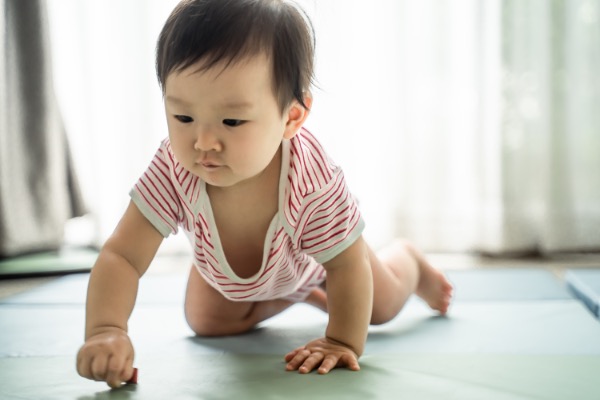At 10 months old, you will start to notice a much more active and expressive baby! The once still baby who would play in one place, happily receiving the toys and objects you offered them, is now moving a bit more and starting to lead play time.
Strings of babbles
By now, many babies say their first word, although not always intentionally. You can expect to hear your munchkin say something like ma-ma, da-da or pa-pa. Even if you don’t get to hear their first word this month, you can definitely expect them to communicate through gestures like waving or pointing. Having said this, another fun milestone is that they’ll begin to imitate gestures they see, so make sure you use lots of gestures and facial expressions when you communicate with him or her. Give your child opportunities to choose between two objects to practice pointing and using non-verbal expressions, as seen in this activity.
A New Range of Movement
Their motor development is also getting them places now! It’s important to note though, that what one 10 month old may be doing at a gross motor level, might be quite different than what another 10 month old is accomplishing. While some are just starting to creep, others are avid crawlers and a few are eager to walk! This may cause anxiety for some parents who compare their baby to another the same age; but rest assured, these differences are to be expected!
A common denominator at 10 months is that most babies will be pulling up to stand! So make sure you are offering lots of opportunities for them to hold on to furniture or even your leg so they can practice! After some practice standing up on furniture, they might begin to “cruise”, meaning they’ll give a few steps sideways while holding on, to move from their starting point to an interesting object further away. To give your baby extra support to practice standing and giving one to two first steps, try a water walking activity.
Now that they have strength to pull up to stand, they will also be eager to explore with climbing stairs, low furniture or even obstacles you can set up for them, although we can mostly expect them to creep and crawl around them since they’re learning how to change directions and they might be easily distracted by an object in their path. (Here you’ll find a fun activity to start working on climbing).
They might use their new language skills to ask you for your hands to stand up or walk. It’s good to respond to their attempts at communicating so acknowledge what they want, but try not to walk them around all the time with your hands. You can offer a helping hand from a sitting position so that they can support their weight on you and maybe walk in for a hug. Walking them around everywhere can be exhausting for you and also counterproductive for them, as they won’t be learning to balance their body themselves and their arms will be upward instead of sideways, where they tend to find balance. Look at this activity to learn how to best support walking.
Pincer Grasp
Last but not least, their fine motor skills are also getting better by the minute! They can now use their thumb and forefinger to pick up small objects like a blueberry on their plate or a pompom in a whisk (like in this activity). So it’s all the most important to have all eyes on your tiny crawler who is finding all sorts of things along their path and are still putting things into their mouth, (although a bit less than before). This evolution of their hand and finger dexterity allows them to flip the pages of a book and put small objects into containers. Check out this activity for putting things IN a container, and this one for taking them OUT!
Here’s a list of the milestones we mentioned above:
- Asks for help by gesturing
- Imitates simple gestures (like clapping hands after seeing someone do it)
- Interacts with other kids during play
- Crawls
- Remains standing while holding on to something
- Stands momentarily with help
- Walks by “cruising” or leaning on furniture
- Walks while holding on to someone with both hands
- Searches for hidden toys
- Climbs or goes around obstacles when crawling
- Changes directions easily when crawling
- Picks up very small objects between their thumb and forefinger (like cereal)
- Grasps objects using only their fingertips
- Flips through pages of a book (even if not one by one)
- Places objects in a container
- Explores alone when a parent or caregiver is nearby








